By sally Siko
By the way, I’ve added more than 80 new birding tour dates to my Best Life Birding trip schedule.
Check out the calendar below and book your next birding adventure with me today!
By sally Siko
By the way, I’ve added more than 80 new birding tour dates to my Best Life Birding trip schedule.
Check out the calendar below and book your next birding adventure with me today!
By Sally Siko
It’s been a good winter of birding so far.
Bird number 180 for the year appeared this morning in the form of a sweet looking Sedge Wren in Durham county NC.
My friend Corie and I spotted it next to a field flitting around in the tangled undergrowth of a sharp thorned bit of scrubby bush.
This little guy was (as is the case with many species of wrens) very, very vocal which made him easy to locate in the dense tangle.
Yet, actually getting a clean look at it (much less a photo lol) was difficult at best.
The problem was that the bird hardly sat still for more than three seconds. Making matters worse, in addition to all of the twigs and leaves between my lens and the bird, the light was very harsh with dark shadows, and blown highlights.
I really tested the limits of my @canonusa R5’s animal eye focus detection lol!
It took us around 45 minutes of waiting for the bird to pop out of the center of the bush, and even then there was always a twig or a leaf partially concealing the view.
In the end I was satisfied with the photos I was lucky to snap and grateful for the opportunity to even see this bird at all.
Success lol!








Sedge Wrens are a winter resident of North Carolina in our eastern counties.
Here in central NC, they are considered a rare sight so spotting one in the Durham area was a real treat.
They are best found in transitional areas where marshes blend into open fields and especially where there are patches of brush for them to hide and stalk prey.
Once called the Short-billed Marsh Wren, these birds are similar looking to the Carolina and Marsh Wrens we’ve got in NC.
Measuring about 4.5in long, Sedge wrens are streaked with black and brown plumage.
They’ve got white bellies and throats, with soft brown buff coloring on the sides and breasts.
Their tails have a black barring pattern on the topside.
What really stands out though is that bill which is noticeably shorter than that of its relatives.
What a cutie!
If you’d like to see this bird for yourself, I’ve attached a screenshot of the birds location.
I hope that you get to see it too 🙂
Photos by @sally_siko of @bestlife_birding on my mighty mirrorless monster, the @canonusa #R5


By Sally Siko
It’s been a good winter of birding so far.
Bird number 180 for the year appeared this morning in the form of a sweet looking Sedge Wren in Durham county NC.
My friend Corie and I spotted it next to a field flitting around in the tangled undergrowth of a sharp thorned bit of scrubby bush.
This little guy was (as is the case with many species of wrens) very, very vocal which made him easy to locate in the dense tangle.
Yet, actually getting a clean look at it (much less a decent photo lol) was difficult at best.
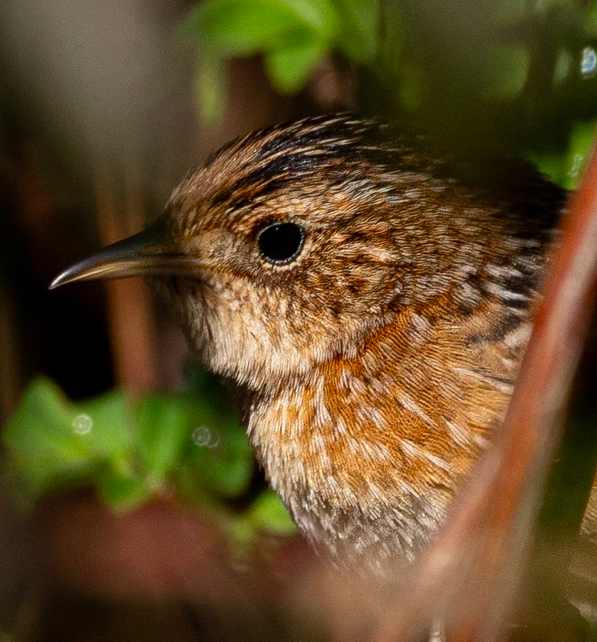
The problem was that the bird hardly sat still for more than three seconds. Making matters worse, in addition to all of the twigs and leaves between my lens and the bird, the light was very harsh with dark shadows, and blown highlights.
It took us around 45 minutes of waiting for the bird to pop out of the center of the bush, and even then there was always a twig or a leaf partially concealing the view.
In the end I was satisfied with the photos I was lucky to snap and grateful for the opportunity to even see this bird at all.
Success lol!
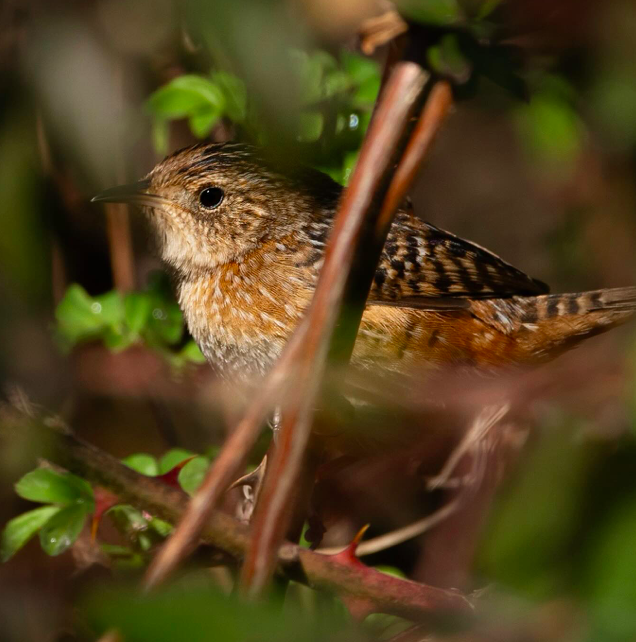

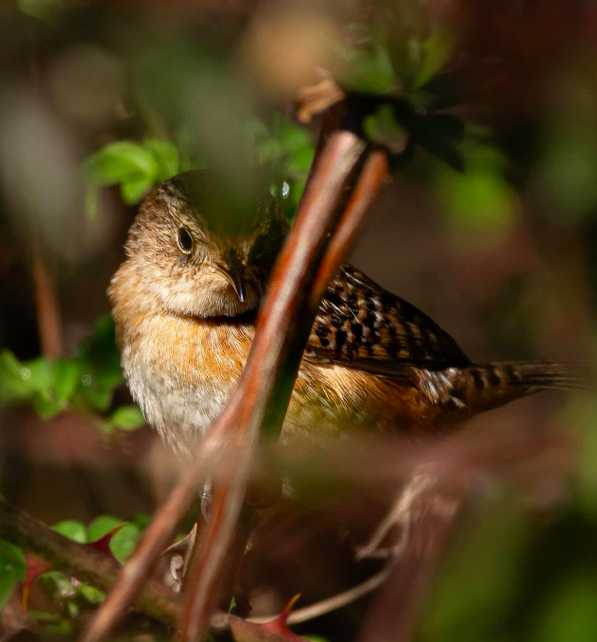
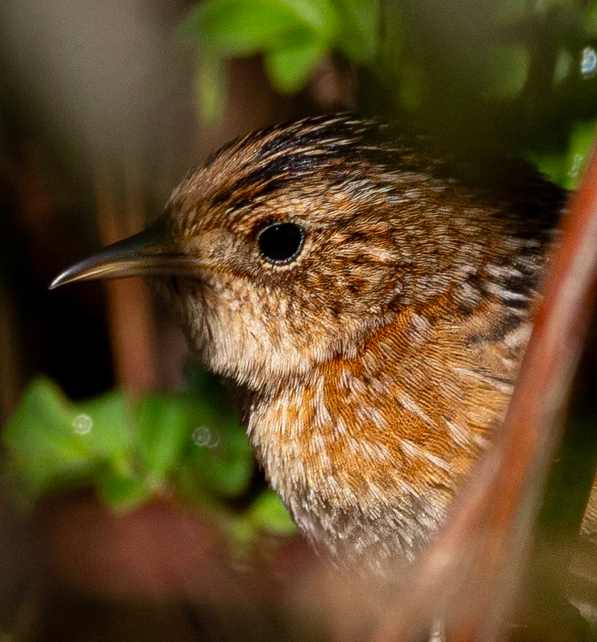

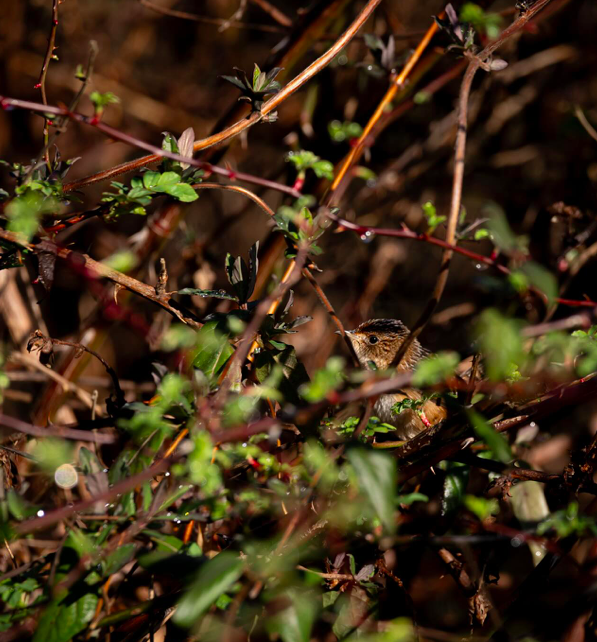
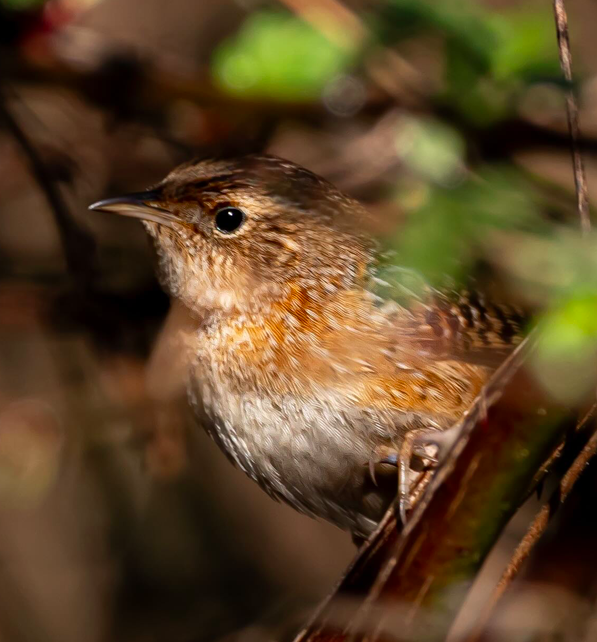

Sedge Wrens are a winter resident of North Carolina in our eastern counties.
Here in central NC, they are considered a rare sight so spotting one in the Durham area was a real treat.
They are best found in transitional areas where marshes blend into open fields and especially where there are patches of brush for them to hide and stalk prey.
Once called the Short-billed Marsh Wren, these birds are similar looking to the Carolina and Marsh Wrens we’ve got in NC.
Measuring about 4.5in long, Sedge wrens are streaked with black and brown plumage.
They’ve got white bellies and throats, with soft brown buff coloring on the sides and breasts.
Their tails have a black barring pattern on the topside.
What really stands out though is that bill which is noticeably shorter than that of its relatives.
What a cutie!
If you’d like to see this bird for yourself, I’ve attached a Google Maps pin to the birds location.
I hope that you get to see it too 🙂
Photos by @sally_siko of @bestlife_birding on my mighty mirrorless monster, the @canonusa #R5
By Sally Siko
Yesterday my friend Corie and I set out to check out a Cackling Goose that had reportedly been seen at the Mayo River SP in Mayodan, NC.
I had a feeling this bird would be a challenge to ID given their nearly identical appearance to the Canada Goose.
And I was right lol!

But what is a Cackling Goose anyway?
Well as you might have assumed by looking at it, these birds were once classified as Canada geese, but in 2004 the American Ornithological Society reclassified the four smallest subspecies of Canada geese as members of a new species known as the Cackling Goose.
Today, four subspecies of cackling geese are recognized by the AOS: the Bering, Aleutian, Richardson’s, and Taverner’s.
All four subspecies largely breed on the treeless tundra lands of Alaska and northern Canada. With the exception of the Richardson’s subspecies, the Cacklers are found almost exclusively in the Pacific Flyway areas.




To make matters more complicated, there are slight variations in the size and shape of the heads within the group of Cackler subspecies as well as subtle plumage variations too.
For what it’s worth, my instinct tells me that this is a Tavener’s Cackling Goose because this goose just looks so similar in proportion and plumage to that subspecies but that would be pretty unlikely given the spot where I found it.
Plus there’s a chance that this bird might just be (a very small sized) Canada Goose too lol.
I’m cool with being wrong with an ID but want to learn what to look for to get this species right going forward.
So bird friends, what do you think, is it a Cackling Goose or a Canada Goose?
Big props sent out if you can ID the subspecies too! Feel free to comment on this post.
I’ve included a Google Maps pin of the goose’s location for reference and in case you’d like to go see it for yourself.
Your opinion (and a detailed explanation) on this ID is much appreciated 🙂
Thank you.
Happy birding!
Photos by @sally_siko of @bestlife_birding on my mighty mirrorless monster, the @canonusa #R5
By Sally Siko
Stoked to lay eyes on a Trumpeter Swan this morning while birding with my friend Corie @latta.ridge at Hanging Rock SP in Danville, NC!

Standing at nearly 4ft tall with a wingspan stretching 5.2ft, and a hefty weight topping 30lbs, Trumpeter Swans are both the largest and heaviest species of waterfowl native to the United States. They are much larger than our wintering Tundra Swans and easy to identify by observing that elongated face and low posture in the water.
I was surprised how curious this guy was as the swan casually swam over to get a look at me as I took these photos. At one point the bird was only a couple feet away though it remained calm and unbothered throughout the entire visit.
These large elegant birds are truly awe inspiring to see up close and I was delighted to encounter such a friendly swan out in the wild.





The other reason that I was thrilled to see this bird is because although the numbers of this species are increasing (currently estimated at 63,000 birds), Trumpeter Swans are a rarely spotted here in the mid Atlantic region of the eastern US.
These elegant birds originally graced wetlands across a broad region of North America from Illinois all the way up into northwest to Alaska.
Unfortunately though, throughout the 17- and 1800s, they were hunted relentlessly for their meat, skins and feathers.
That combined with habitat loss meant that by the 1930s, only 69 Trumpeter Swans remained in the lower 48 states, living in the remote Red Rock Lakes area in southwestern Montana.
Crazy!
Thanks to modern conservation practices, this species is recovering however their future remains uncertain due to continued habitat loss and lead shot poisoning.
We almost lost them but at least we’ve got a chance to today to ensure the survival of this magnificent bird.
If you’d like to go see the spread for yourself, here is a Google Maps pindrop of its location at the bottom of this post.
I don’t know how much longer this big boy will remain at the lake, but it’s probably worth a look if you’re anywhere in the area.
Photos by @sally_siko of @bestlife_birding on my mighty mirrorless monster, the @canonusa #R5
By Sally Siko
Here’s another uncommon bird I spotted while birding in Raleigh NC, the Vesper Sparrow.
I’d set out to find one of these beauties along Mid Pines road and was rewarded with some great close up looks as they perched on the fence line.
I’ve seen this species before in the same area but the only photos I’d ever managed to take were terribly lit and from below so it was nice to actually capture a couple shots at eye level.
I know sparrows don’t typically catch anyone’s attention but I absolutely adore these tiny birds.
Aren’t they sweet?

Although they do breed in the western counties of the Tarheel state, the Vesper Sparrow are an uncommon sight here in NC. Usually they are spotted during migration but unfortunately numbers of this species are in overall decline so seeing one is indeed a treat at anytime of the year.
As with many other sparrows, the Vespers favor weedy field habitats with sparse grass cover mixed with bare ground. Interestingly they seem to like hanging out with Song Sparrows and Savannah Sparrows so it’s worth double checking who’s who when ya encounter mixed flocks.
The easiest way to ID these guys is to look for a streaky breasted sparrow that has prominent white eye ring combined with white outer tail feathers which are most noticeable when they’re in flight.





These lovely feathered gems should hang out in central North Carolina until mid March.
If you’d like to find these birds at Mid Pines Rd, I’ve included a couple screenshots of their exact location in this post.
I hope that you get to see them too!
Photos by @sally_siko of @bestlife_birding on my mighty mirrorless monster, the @canonusa
By Sally Siko
Had a window of free time this morning so I took a quick trip up to Dix Park in Raleigh to see if I could find a Clay colored Sparrow which had been reported there this past week. It took some walking but eventually I finally got a good look at this rare (for the region) species with a couple other birders (shoutout to Adam & Davon!). Woohoo!
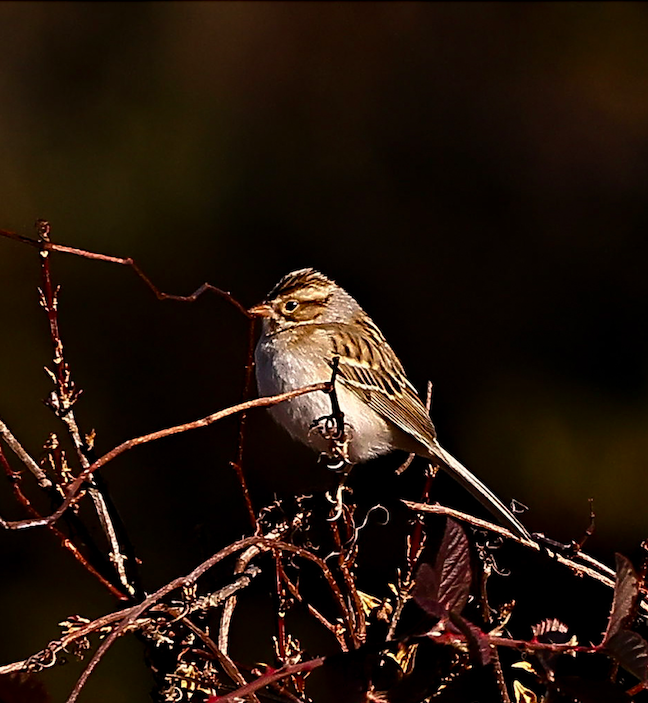
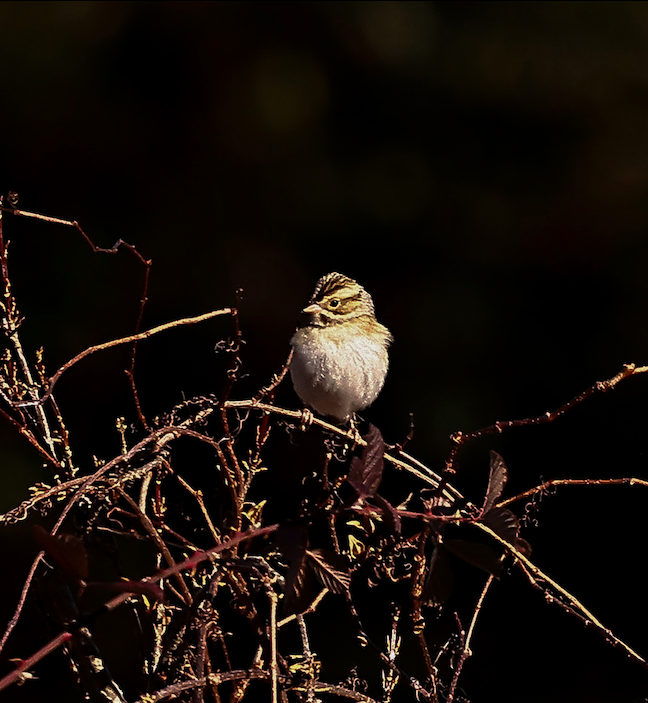
Why is it a special thing to see this bird here in North Carolina? Well, normally the range of the Clay-colored Sparrow stretches from central Canada, down through the Midwest states of the central US into Texas and northern Mexico which means this little guy is well out of his range. It’s not a state record however, since increasing numbers of Clay-colored Sparrows have been showing up in North Carolina since the 1980s. When they do show up, usually they are found during the wintertime in our eastern counties so seeing one here in the central part of the state was pretty cool!
As was the case today, these little ones are most often found with groups of Field Sparrows and Song Sparrows, usually lurking in brush piles, hedgerows, weedy fields, and in the tangled margins of open fields. In fact it was easier to find this Clay-colored by looking for a flock of Field Sparrows making their way around the margins of the sunflower field which ended up being the key to locating the bird.
If you’d like to go see this bird for yourself, I’ve included a Google Maps pin drop link of its location next to the parking lot at Dix Park in Raleigh.
Happy birding!
By Sally Siko
Here’s a bird I was surprised to see while birding in eastern North Carolina yesterday, an Ash-throated Flycatcher!
The normal range for these little dynamos typically stretches from California to Texas so spotting one here on the east coast is a real treat.
I actually heard this bird calling out “ka-brick” before I found it so it was neat to zone in on that one patch of tall grass to finally get a photo after hearing it vocalize.

Aptly named, Ash-throated Flycatchers do indeed snack on flies. They’re also voracious eaters of all kinds of other insects such as grasshoppers, wasps, bees, cicadas, termites, moths, caterpillars, beetles, spiders and dragonflies.
As desert dwellers, water can be tough to find but that’s not a problem for them since they can get all the water they need from the insects which they consume. This unique dietary adaptation allows them to live in harsh dry environments where other species might not be able to thrive.
Here in NC, we’ve got plenty of water and insects which should carry this little one through the winter months if it chooses to stay.

Though the Ash- throated Flycatcher is not native to North Carolina, sightings of this “rare for the area” bird have been increasing in recent years.
It appears that a few individuals seem to favor the Alligator River NWR and the Pungo Unit as their winter destination of choice.
If I remember correctly, I think there were a pair of them sighted at the ARNWR back in 2022 which makes me wonder if this bird is one of the two which had visited before.
Generally, these flycatchers show up in late November with sighting reports dwindling by late February so my advice is to get out there as soon as you can to lay eyes on this feathered gem.
If you’d like to find bird for yourself, I’ve included a link of its exact location in this post.
Hope you get to see it too!
Photo by @sally_siko of @bestlife_birding on my mighty mirrorless monster, the @canonusa #R5


By Sally Siko
Nice to catch another look at a Ross’s Goose today in Raleigh NC!
I hadn’t seen this species in three years and weirdly enough, this bird showed up on the same property where I found one back in 2021.
When I arrived at its reported location near Yates Mill Park late this afternoon, I’d expected that it would be feeding in the fields near the small pond where it had first been reported swimming.
From what I can tell about ducks and swans found in agricultural areas (like this one) they tend to feed in the fields during the day, returning to the water at night to sleep.
Since I was getting a late start at seeing the bird, I was really hoping that it would still be on dry land instead of on the pond because close access to the water is restricted.
As luck would have it, I found the goose in a field behind a church happily feeding with a flock of Canada Geese.
So cool!

Ross’s Geese are an unusual sight in central NC as they typically migrate further to the east to spend the winter in our coastal waterfowl impoundment and marshes. Normally your best bet in seeing them is at Pea Island, Lake Mattamuskeet, or the Pungo Unit where they will hang out amidst flocks of Snow Geese. Thus, seeing them in the Raleigh area is pretty special, earning them a rare status. That being said, there have been growing numbers of sightings of Ross’s Geese further inland over the past 20 years so maybe this sighting is right on trend.



Since the Ross’s Goose and Snow Goose look so similar, it can make for a tough ID in the field. The best way to tell them apart is that Ross’s Geese are smaller and lack the broad black edges of the bill (known as a “grinning patch”) that Snow Geese show. They’ll stick around the Tarheel state until late February so if your winter birding plans lead you to our coast this winter, you should have a good opportunity to enjoy them for a few more months.
If you’d like to go see this goose here in the Raleigh area, I’ve included a link to the birds location (near Yates Mill Park/ Mid Pines Rd) below.
Park in the lot behind the Antioch Church and look for it in the fields south between the two ponds. Just be sure not to walk or drive past the No-Trespassing sign beyond the first pond.
Photos by @sally_siko of @bestlife_birding on my mighty mirrorless monster, the @canonusa #R5
By Sally Siko
Yesterday Michael and I got up early and drove up to the Guilford County Farm in Elon NC to see if we could spot a Short-eared Owl.
I’d seen reports of one hanging out there and since I’d never spotted this species before, I figured it was worth the trip to try and this lifer to my list.
Once we arrived, we decided to walk through the fields to see if we could lay eyes on one sitting in the field.

Happily, it didn’t take but 15 minutes to spot one of these beauties taking off from the grass.
Although the Shortie was pretty far away and the photos I took aren’t the greatest it was a thrill to finally lay eyes on this beautiful bird!
But then it got even better as a second then third owl appeared swooping overhead!
Then things got really interesting as a flock of crows flew in and set off after the Shorties.
Diving and slicing through the air, the owls deftly out maneuvered the crows at every angle, eventually frustrating their pursuers into giving up.
That encounter is a good reminder in that if you ever want to find an owl, look (and listen) for a pack of angry crows!



Luckily for birders and photographers alike, Shorties are one of a handful of species of owls which can be seen flying over our marshes, un-filled waterfowl impoundments and wet fields during daylight hours (especially morning and in the afternoon).
They are more numerously found in our coastal counties especially at the Alligator River NWR and at Phelps Lake but may also be spotted (usually in smaller numbers) inland in agricultural areas throughout the Piedmont region.
Though there have been sporadic reports of this species breeding in the Tarheel state, Short-eared Owls are generally wintertime residents of North Carolina. Look for these beauties from now through late March.
If you’d like to make a trip out to the Guilford County Farm to see these guys for yourself, I’ve included a Google Maps pin drop of their exact location in the fields between County Farm Rd and Howerton Rd. in this post.
Good luck and happy birding!
Photos by Sally Siko of @bestlife_birding captured on my mighty mirrorless monster, the @canonusa #R5